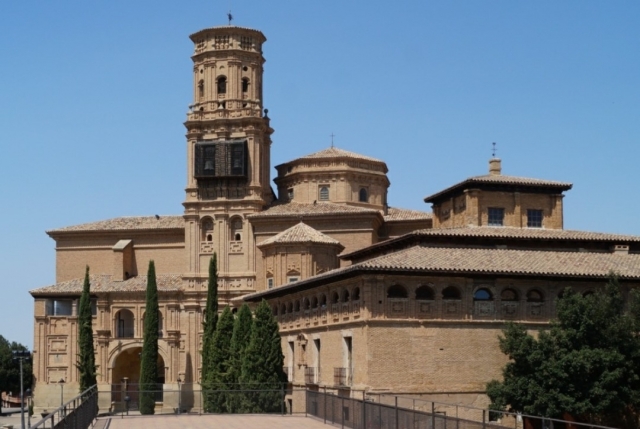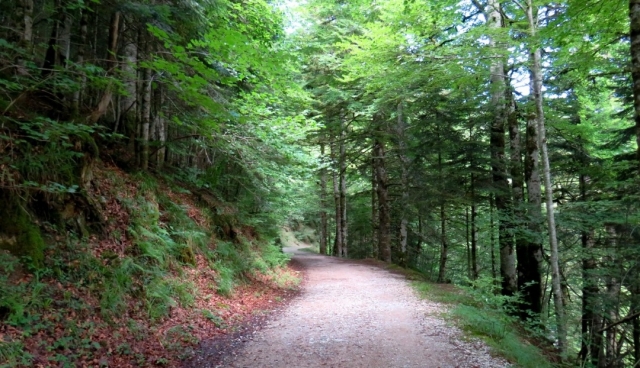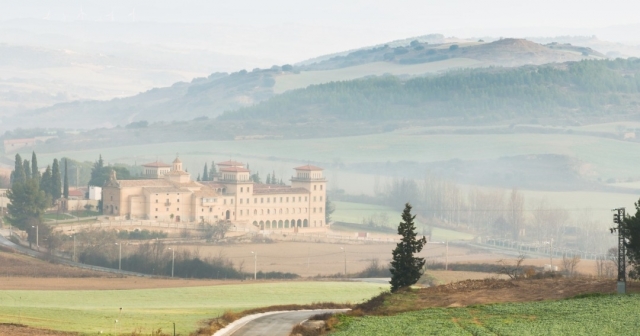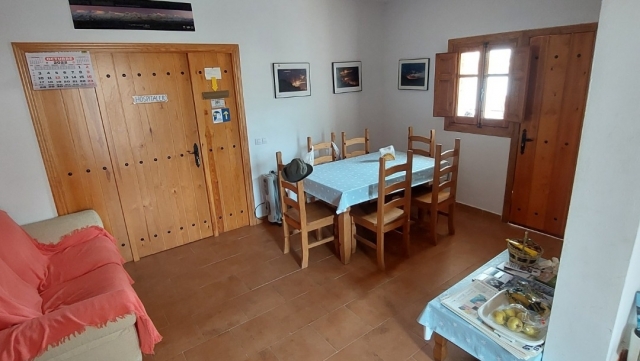Doing the Way of Saint James from Navarra
Camino de Santiago from
Discover everything you need to do the Camino de Santiago from the city of Navarra: distance, routes, monuments and tips
- Camino de Santiago from Madrid
- Camino de Santiago from León
- Camino de Santiago from Sarria
- Camino de Santiago from Roncesvalles
- Camino de Santiago from A Coruña
- Camino de Santiago from Seville
- Camino de Santiago from Ponferrada
- Camino de Santiago from Burgos
- Camino de Santiago from Ourense
- Camino de Santiago from Bilbao
- Camino de Santiago from Oporto
- Camino de Santiago from Lisboa
- Camino de Santiago from Barcelona
- Camino de Santiago desde Pamplona
- The Camino de Santiago from Irun
- The Camino de Santiago from Astorga
- Camino de Santiago from Valencia
- The Way of Saint James from Saint-Jean-Pied-de-Port
- Camino de santiago from Viana do Castelo
- Doing the Way of Saint James from Zamora
- Doing the Way of Saint James from Zaragoza
- Doing the Way of Saint James from Alicante
- Camino de Santiago from Santander
- Camino Portugués from Coimbra
- Camino de Santiago from San Sebastián
- Camino de Santiago from Vigo: Guide of stages
- Camino de Santiago from Salamanca
- Camino de Santiago from Villafranca del Bierzo
- Camino de Santiago from Pontevedra
- Do the Camino de Santiago from Almería
- Camino de Santiago from Valladolid
- Doing the Way of Saint James from Navarra
Why do the Camino de Santiago from Navarra?
Starting the Camino de Santiago from Navarra is quite an adventure. A journey through one of the most emblematic stages of the French Way, offering the pilgrim the opportunity to contemplate in its maximum splendor a natural and cultural environment with unique characteristics.
If Navarra stands out for something, in addition to its gastronomy or the culture so deeply rooted in the area, it is for its diversity of landscapes. The imposing Pyrenees to the fertile valleys and vineyards are just some of the postcards that we can find along the different stages that take us from Navarra to Santiago de Compostela.
As we have already told you, Navarra is a region that also stands out for its rich history and enormous cultural heritage; Special mention goes to a multitude of monuments and places of great importance such as the church of Santa María de Eunate or the bridge over the Arga River in Puente la Reina, to name a few examples. ;
In short, there are plenty of excuses to travel to Navarra and begin the Camino de Santiago from this region. Its incredible and spectacular landscapes, together with its cultural heritage and an ideal infrastructure for any pilgrim, makes Navarra an ideal starting point to begin the trip.
What take into account before doing the Camino from Navarra?
Long before starting the trip on the Camino de Santiago from Navarra, it is crucial that you pay attention to some essential aspects that can make the trip much more bearable.
The first point you should consider is the equipment. Ask ourselves questions like what? What I carry in my backpack for the Camino de Santiago is something very common. At ViveCamino we have extensively covered everything you need for your backpack. From the hygiene material, to what you will use during long walks, to the contents of the first aid kit and that less obligatory but also recommended equipment.
It will also be It is necessary to familiarize ourselves with the stages that we are going to go through throughout the days. Points like what We can meet throughout the days in terms of types of terrain and of course the reservations on the Camino de Santiago are essential to travel with peace of mind.
This leads us to talk about another of the essential characteristics: the climate and the time of year. Is there the best time to do the Camino de Santiago? In reality, the answer depends on each person, since some will prefer the tranquility of the stages in winter, knowing that these will be harder due to the cold. Others, however, and due to their weather, will have no choice but to choose to do the Camino de Santiago in summer, enduring the high temperatures. As much as possible try to carry out the pilgrimage in spring. The temperatures are perfect, both during the night and during the day, so you should have no problem in that regard. The stages, with an influx of pilgrims, do not reach the saturation that can be found during the summer months.
In the same way that it is important to take into account the reservation of hostels or hostels, as well as Like the weather, it is very important to pay attention to physical preparation. The reason is very simple: The Camino de Santiago is a very demanding test. It will be many days traveling dozens, if not hundreds, of kilometers. The months before the start of the trip you will have to prepare. Start with small walks and as the days go by, gradually increase the distance as you go. like the type of terrain. Also remember to use the recommended equipment during this stage, paying special attention to the boots.
Finally, and also worth noting, take a few minutes to know why you want to do the Camino de Santiago. Is it a promise or is it a physical challenge? Will it be A spiritual or personal journey with a group of friends? These questions, and of course their answers, will be important so that the pilgrimage takes on even more meaning and strength.
All the stages of the Camino de Santiago from Navarra
The Camino de Santiago from Navarra covers several key stages, starting fromSaint-Jean-Pied-de-Port or Roncesvalles; passing through Pamplona, Puente la Reina, Estella and Los Arcos. From here We will continue our way through La Rioja, continuing through the rest of Spain until we reach Santiago de Compostela.
As we have already mentioned, each and every one of the stages has unique and extremely beautiful landscapes: mountains, vineyards, and areas full of enormous cultural and architectural wealth will be part of the day to day in each of the stages.
Below you will find a list of all and each of the stages traversing the Camino de Santiago from Navarre, being the French Way a very important part of this route. But it is not the only one as the Camino Baztanés, for example, is another very good alternative next to the Aragonés Branch.
Stages of the French Way from Navarre
Stage 1: Saint-Jean-Pied-de-Port - Roncesvalles (24.7 km)
Stage 2: Roncesvalles - Zubiri (21.5 km)
Stage 3: Zubiri - Pamplona (20.4 km)
Stage 4: Pamplona - Puente La Reina (24.6 km)
Stage 5: Queen - Star Bridge (22.6 km)
Stage 6: Star - Los Arcos (21.8 km)
Stage 7: Los Arcos - Achievement (28 km)
Stages of the Baztani Trail from Navarre
Stage 1: Bayonne - Ustaritz (15.5 km)
Stage 2: Ustaritz - Urdax (20.3 km)
Stage 3: Urdax - Elizondo (19.4 km)
Stage 4: Elizondo - Berroeta (10 km)
Stage 5: Berroeta - Olague (22.2 km)
Stage 6: Wave - Pamplona (24.2 km)
From this point onwards it will be shared. the route with the French Trail.
Stages of the Aragonese Trail
Stage 1: Artieda - Sanguesa (28 km)
Stage 2: Sanguesa - Monreal (26.5 km)
Stage 3: Monreal - Queen Bridge (30.4 km)
From this point on we will join the French Way.
¿When to make the Way of James from Navarre?
As we have already mentioned, the best time to do the Camino de Santiago from Navarre is spring. In winter you will find less influx of pilgrims on the paths, something to highlight, but also due to the low temperatures and the bad weather highlighting especially the rain and wind. In summer, on the contrary, the stages show a higher number of pilgrims, but temperatures can get downright high in some regions.
The former however offers us much milder temperatures, both during the morning and evening, facilitating periods of walking and rest. In addition during this time of year we can find hostels and hostels without booking being a problem.
¿Where to sleep and where to eat?
It is basic that everything regarding where to sleep on the Camino de Santiago is one of the main parts of the trip preparation. Take an in-depth look at the different stages you are going to go through during the journey. and from thereinvestigate the different options for rest, be it hostels or hostels. As we have already mentioned you should have no problems finding a roof to sleep on if you decide to start in spring.
If we talk about food, gastronomy is one of the strong points of northern Spain. Whether in Navarre as along the French Way and the rest of the journey until reaching Santiago, gastronomy plays a fundamental role, being the favorite of both those pilgrims who prefer to decant by dishes where meat plays an important role, such as spoon dishes.
¿How to get to Navarre to do the Way of St. James?
Navarra offers no communication problems with other cities, at least the main ones in Spain. To get to Navarra from Madrid by car we must take the A-2 and then the AP-68 to Logroño, continuing later on the A-12 towards Navarra. In the case of Barcelona, the AP-7 and A-2 lead to Lleida, from where the A-22 is picked up and then the AP-68 to Logroño, followed by the A-12 to Navarra.
¿Do you want to get to Navarre by train? You won’t find any problem either. From Madrid there are direct trains to Pamplona from Atocha station. To catch the train from Barcelona you have the Barcelona-Sants station, also with direct trains to Pamplona. On the other hand, nearby cities such as Zaragoza or Logroño have good bus connections and three direct to Pamplona, facilitating thus traveling to Pamplona. the access to Navarre.
- Camino de Santiago from Madrid
- Camino de Santiago from León
- Camino de Santiago from Sarria
- Camino de Santiago from Roncesvalles
- Camino de Santiago from A Coruña
- Camino de Santiago from Seville
- Camino de Santiago from Ponferrada
- Camino de Santiago from Burgos
- Camino de Santiago from Ourense
- Camino de Santiago from Bilbao
- Camino de Santiago from Oporto
- Camino de Santiago from Lisboa
- Camino de Santiago from Barcelona
- Camino de Santiago desde Pamplona
- The Camino de Santiago from Irun
- The Camino de Santiago from Astorga
- Camino de Santiago from Valencia
- The Way of Saint James from Saint-Jean-Pied-de-Port
- Camino de santiago from Viana do Castelo
- Doing the Way of Saint James from Zamora
- Doing the Way of Saint James from Zaragoza
- Doing the Way of Saint James from Alicante
- Camino de Santiago from Santander
- Camino Portugués from Coimbra
- Camino de Santiago from San Sebastián
- Camino de Santiago from Vigo: Guide of stages
- Camino de Santiago from Salamanca
- Camino de Santiago from Villafranca del Bierzo
- Camino de Santiago from Pontevedra
- Do the Camino de Santiago from Almería
- Camino de Santiago from Valladolid
- Doing the Way of Saint James from Navarra
Routes
Blog
 How to get to Sarria to do the Camino de Santiago
How to get to Sarria to do the Camino de Santiago
 Descubre la magia del Camino de Santiago Portugués por la costa
Descubre la magia del Camino de Santiago Portugués por la costa
 5 tours culturales que puedes hacer en Galicia si decides hacer un alto en el camino
5 tours culturales que puedes hacer en Galicia si decides hacer un alto en el camino
 Doing the Camino de Santiago in June: What you should know?
Doing the Camino de Santiago in June: What you should know?
Information
Points of interest
Cities & Towns | Hostels | Lodgings | Restaurants | Saddlery | Doctors | Points of interest | Bikes workshop
Contact us | Privacy policy | Cookies policy | | Terms of use | Authorship | Web Map | Consentimiento
© Copyright LA VOZ DE GALICIA S.A. Polígono de Sabón, Arteixo, A CORUÑA (ESPAÑA) Inscrita en el Registro Mercantil de A Coruña en el Tomo 2438 del Archivo, Sección General, a los folios 91 y siguientes, hoja C-2141. CIF: A-15000649
Developed and managed byHyliacom



